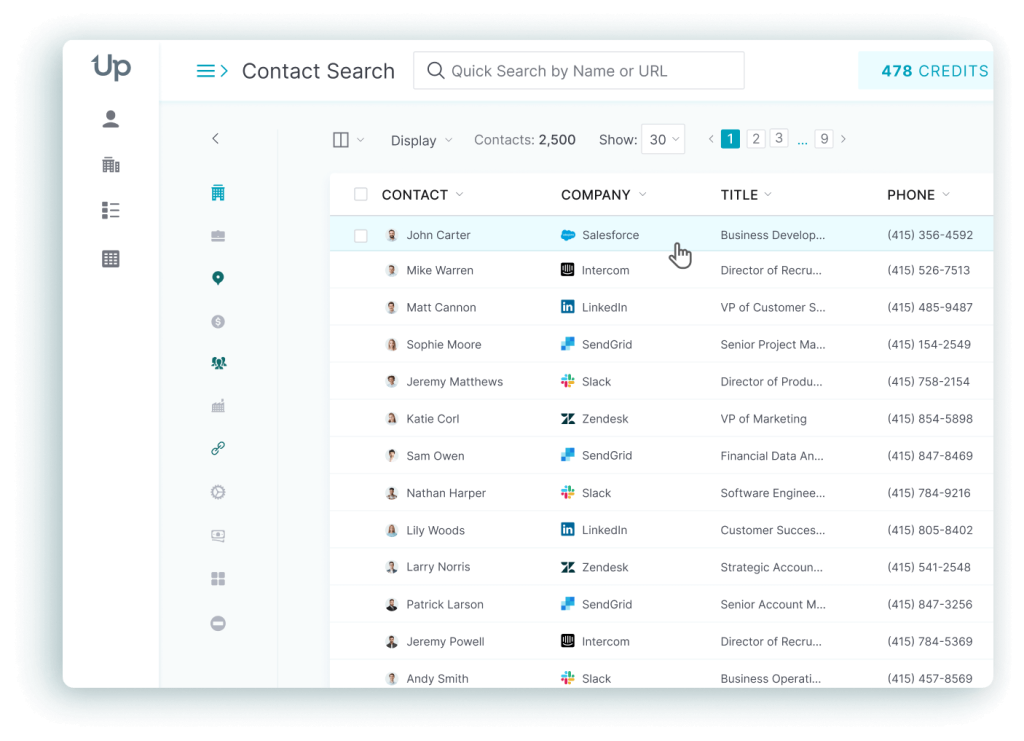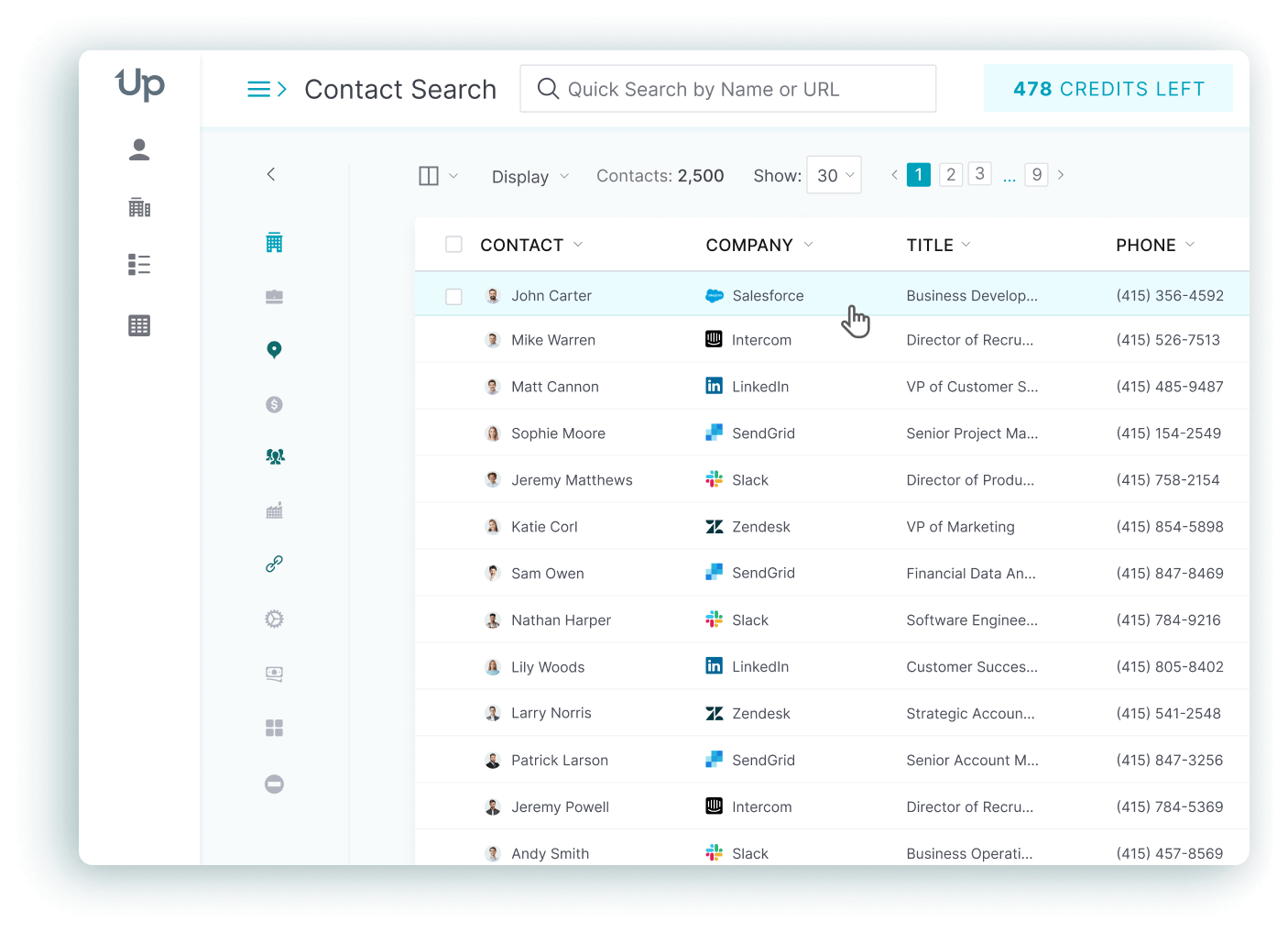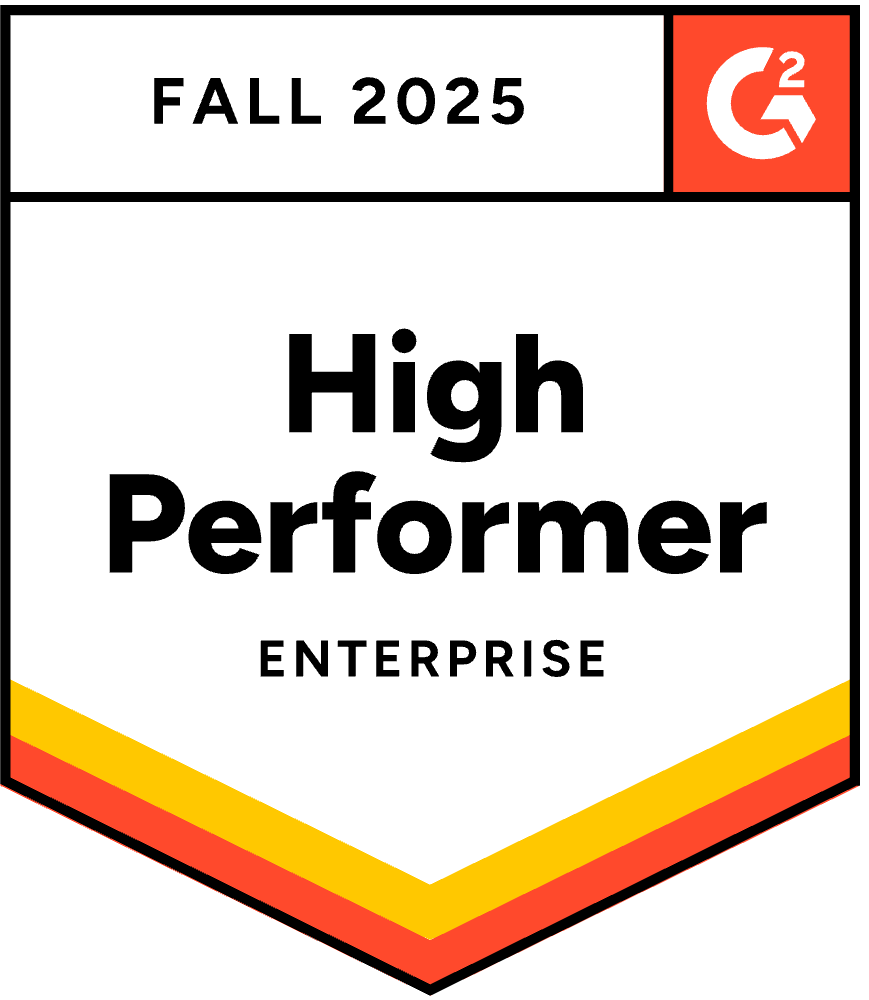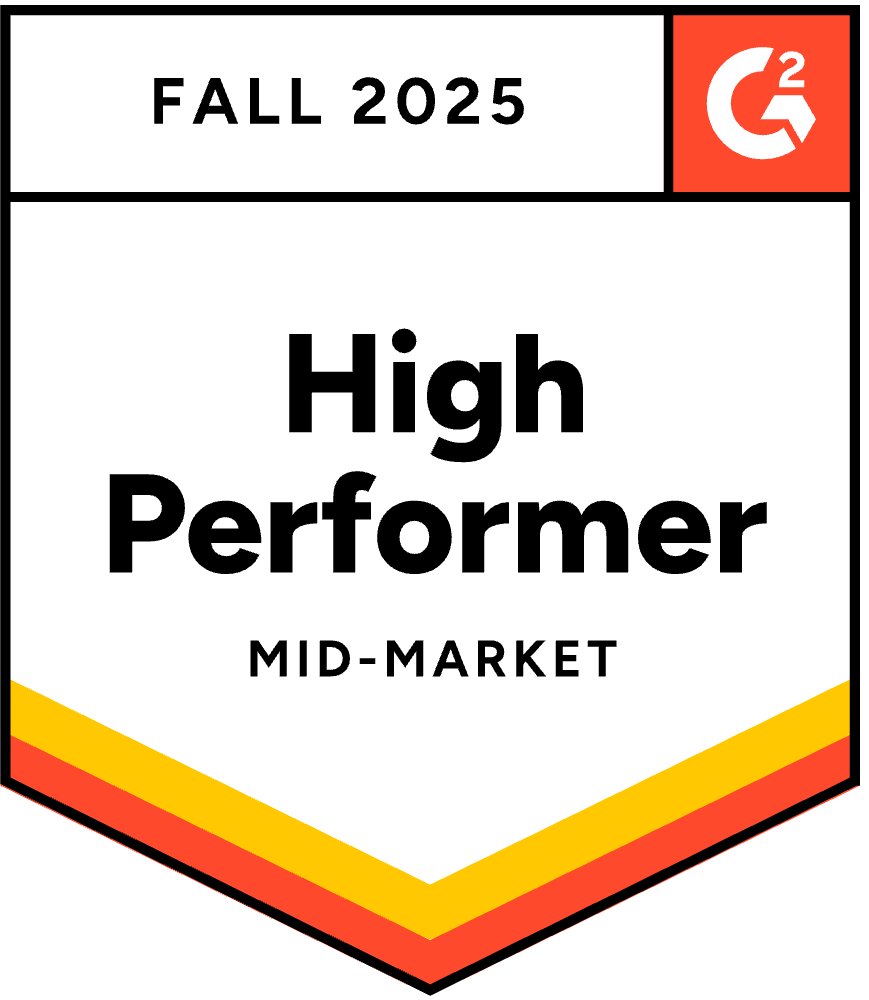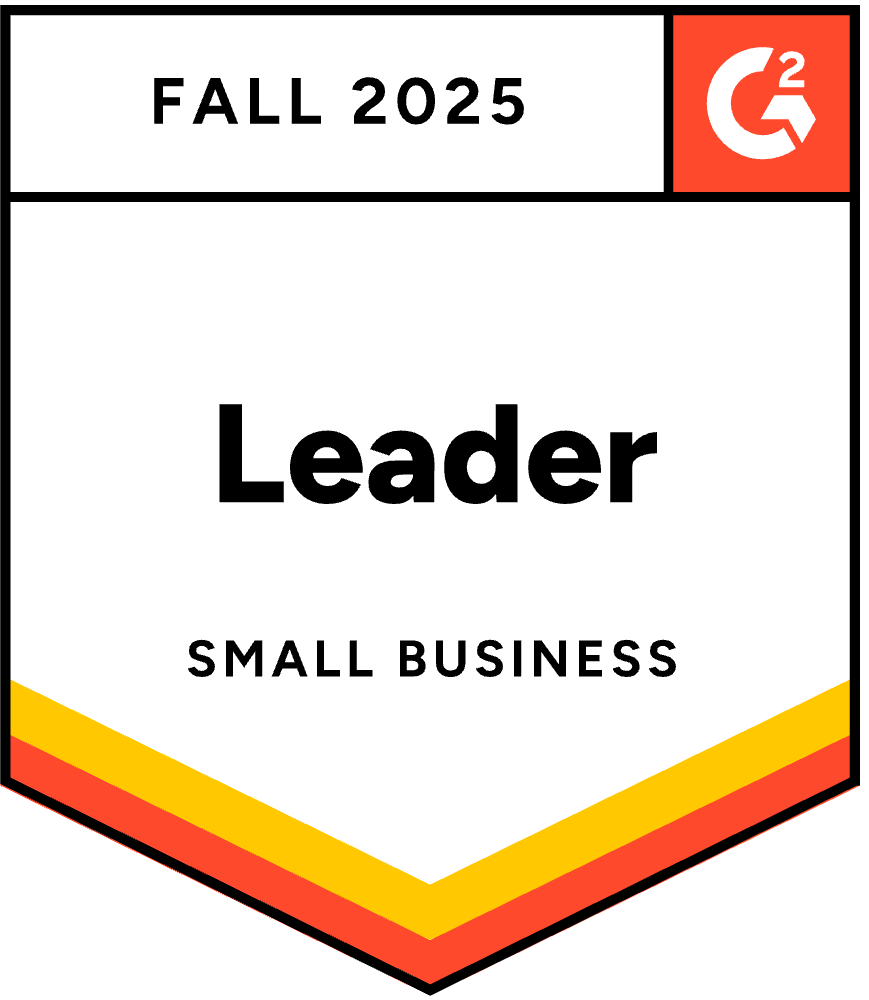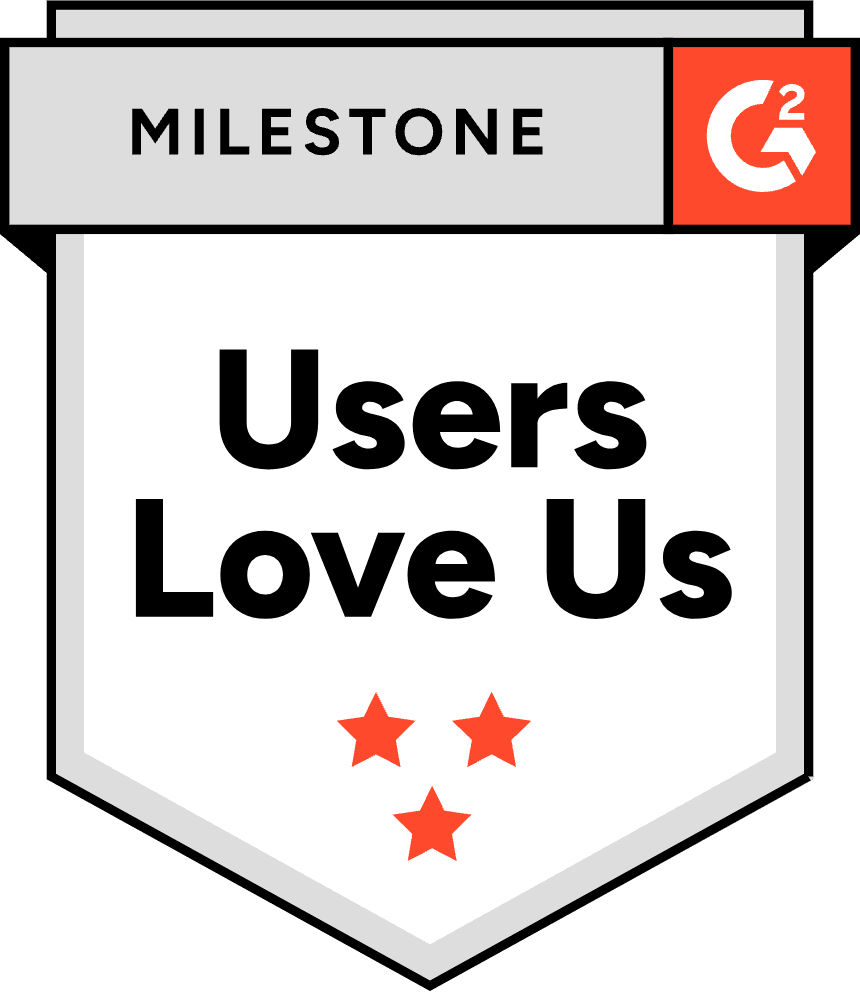I’ll be honest: when I first heard about AI revolutionizing lead generation, I was skeptical.
Another buzzword promising to solve every sales problem?
But after watching our team increase qualified leads by 341% using AI-powered prospecting tools (while cutting research time from 45 minutes to 6 minutes per prospect), I became a believer.
The examples and workflows you’ll see throughout this guide come directly from our own lead generation processes at UpLead, where we’ve tested these strategies across hundreds of campaigns to identify what actually drives results.
What is AI Lead Generation
AI lead generation is the application of artificial intelligence technologies to automate and optimize the process of identification, qualification, and nurturing of potential customers. Instead of manual LinkedIn searches for hours, AI algorithms analyze massive datasets to pinpoint prospects who match your ideal customer profile and show buying intent signals.
Modern AI-powered lead generation combines machine learning, natural language processing, and predictive analytics to transform how sales and marketing teams find and engage prospects. The result? Lead generation that’s faster, more accurate, and dramatically more cost-effective than traditional manual processes.
Benefits of AI Lead Generation
AI-powered tools deliver transformative advantages that reshape how sales teams operate. Companies report measurable improvements across every key performance indicator, from lead quality to conversion rates.
Key benefits include:
- Massive time savings through automation (60%+ task reduction)
- Superior lead quality and precision targeting (3x conversion likelihood)
- Dramatic scale without proportional headcount increases
- Cost reduction across operations (25% lower CAC)
- Personalization at scale (40% higher response rates)
- Real-time intelligence and actionable insights
- Improved conversion rates through AI optimization (23%+ average increase)
Massive Time Savings Through Automation
AI tools reduce average prospecting tasks by 60%+, with sales teams saving 2 hours daily on research and qualification. McKinsey research shows generative AI could automate 60-70% of employee work hours, freeing human resources for relationship building and strategic initiatives.
Superior Lead Quality and Targeting
AI algorithms identify prospects 3x more likely to convert through analysis of behavioral patterns and firmographic data. Intent-driven leads convert at 20-25% rates compared to 5-10% for traditional leads, per Forrester Research. This precision targeting identifies high value prospects while filtering unqualified leads.
Dramatic Scale Without Proportional Headcount
Process 1,000-5,000 leads monthly automatically, rather than the 50-100 a human rep can handle. Salesforce research shows companies using AI tools see 451% increases in qualified leads while maintaining or improving lead quality.
Cost Reduction Across Operations
Cut customer acquisition costs by 25% through automation while reducing cost per qualified lead by 50% over time. Harvard Business Review research shows AI implementations deliver 40-60% cost cuts in business process automation, with 93% of organizations reporting substantial savings.
Personalization at Scale
Generate customized outreach for hundreds of prospects simultaneously, achieving 40% higher response rates than generic templates. Netflix saves $1 billion annually through AI-powered personalization, demonstrating the power of data-driven customization.
Real-Time Intelligence and Insights
Monitor prospect behavior, company changes, and buying signals as they happen, which enables perfectly timed outreach. Gartner research shows AI augmentation will create $2.9 trillion in business value through improved decision making and actionable insights.
Improved Conversion Rates
AI-powered personalization and timing optimization increase conversion rates by 23% on average, with some implementations showing improvements up to 77%. Adobe research demonstrates that 97% of marketers see better results with AI-driven personalization strategies.
How to Use AI for Lead Generation: A Closer Look
The magic happens when you understand exactly how to deploy AI across your entire lead generation funnel. The strategies below come directly from our own workflows at UpLead, where we’ve tested these approaches across hundreds of campaigns to identify what actually drives measurable results.
List Building & Lead Generation Tasks
AI powered lead generation transforms the most time-consuming part of prospecting into an automated workflow that generates leads at unprecedented scale.
Step-by-Step Implementation:
Step 1: Define Your Ideal Customer Profile in UpLead
Log into UpLead’s Prospector and set these specific filters based on our proven targeting methodology:
- Industry: Software/SaaS (or your target vertical)
- Employee count: 50-200 (adjust for your deal size)
- Revenue: $10M-$50M (match your pricing tier)
- Location: United States (or your geographic focus)
- Intent topics: “Marketing Automation” (select relevant buying signals)
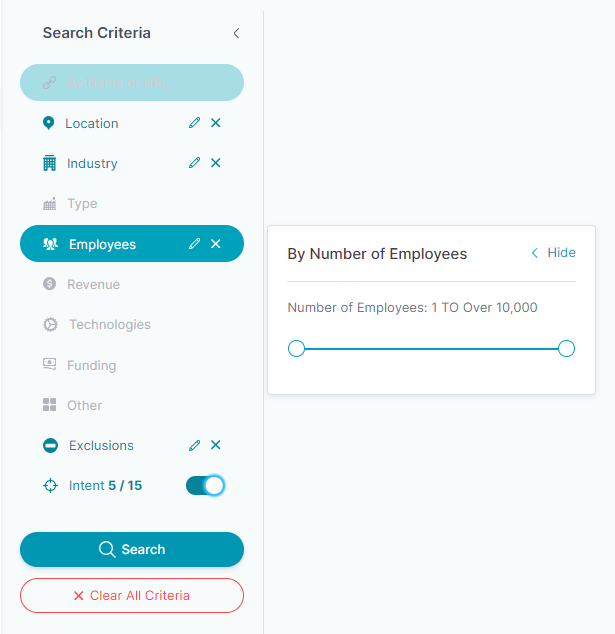
Step 2: Layer Technographic Filters
Add technology filters to identify prospects already using complementary tools:
- Current technologies: Salesforce, HubSpot, or Marketo
- Exclude: Your direct competitors
- Include: Integration-friendly platforms
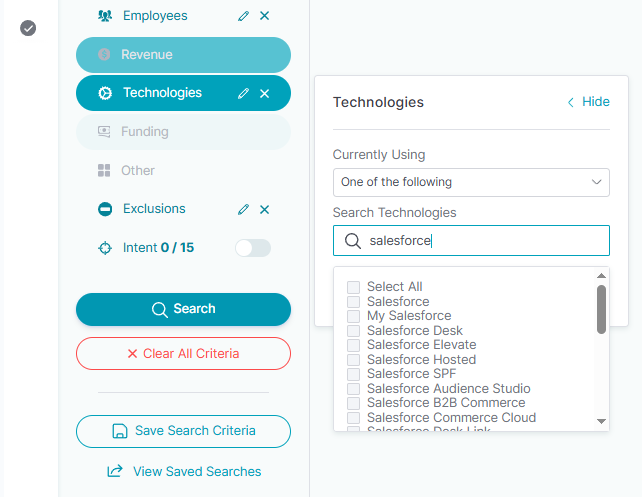
Step 3: Export and Enrich in Salesforce
Download your qualified list (target 500-1,000 prospects initially) and push directly to Salesforce using UpLead’s native integration. The system automatically creates lead records with 95% verified contact information.
Step 4: Use ChatGPT for List Analysis. Paste your exported company list into ChatGPT with this prompt: Analyze these companies for common characteristics and suggest 3 additional criteria I should consider: [paste company names and industries]
Please structure your analysis using proven prospecting principles:
- Identify firmographic patterns (size, industry, growth stage)
- Look for technographic commonalities (tech stack, integrations)
- Note timing indicators (funding events, hiring patterns)
- Suggest specific, measurable targeting criteria
- Prioritize actionable insights over general observations
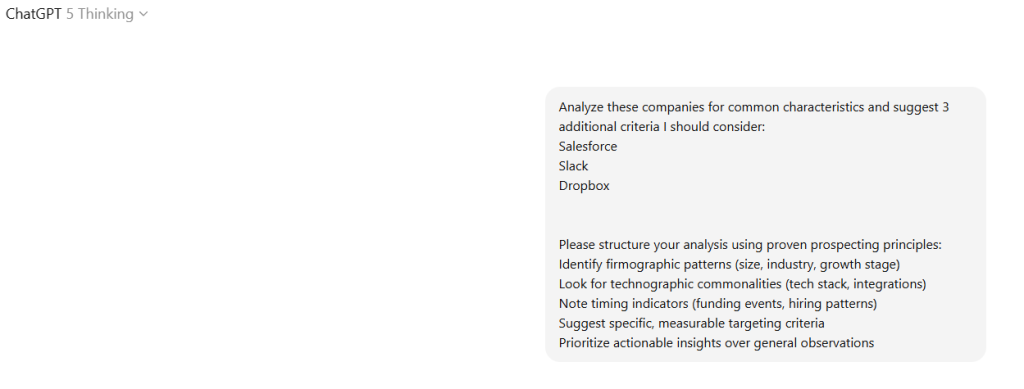
Sample ChatGPT Output:
Based on your company list analysis, I’ve identified these patterns:
Common Characteristics:
– 78% are Series B-C stage SaaS companies
– 65% use Salesforce + marketing automation stack
– Average employee growth rate: 45% year-over-year
Additional Targeting Criteria:
1. Recent funding events (Series B+ in last 18 months)
2. Marketing job postings (indicates team scaling)
3. Integration-heavy tech stacks (suggests sophistication)
These patterns suggest your ICP values seamless integrations and scalable solutions during rapid growth phases.
Enrich Lead Data
Data enrichment fills the gaps that kill conversion rates and transforms incomplete records into actionable prospect profiles that enable personalized outreach.
Step-by-Step Implementation:
Step 1: Audit Your Current CRM Data
Run this Salesforce report to identify gaps:
- Leads missing email addresses
- Contacts without phone numbers
- Accounts lacking firmographic data
- Records without recent activity tracking
Step 2: Prepare Data for UpLead Enrichment. Export your incomplete records to CSV with these minimum fields:
- First Name
- Last Name
- Company Name
- Company URL (crucial for accurate matching)
Step 3: Upload to UpLead’s Data Enrichment Tool
Navigate to UpLead’s Enrich section and upload your CSV file. Select these enrichment preferences:
- Email verification: “Valid emails only”
- Phone number coverage: Include direct dials and mobile
- Firmographic data: Revenue, employee count, industry classification
- Technographic data: Current technology stack
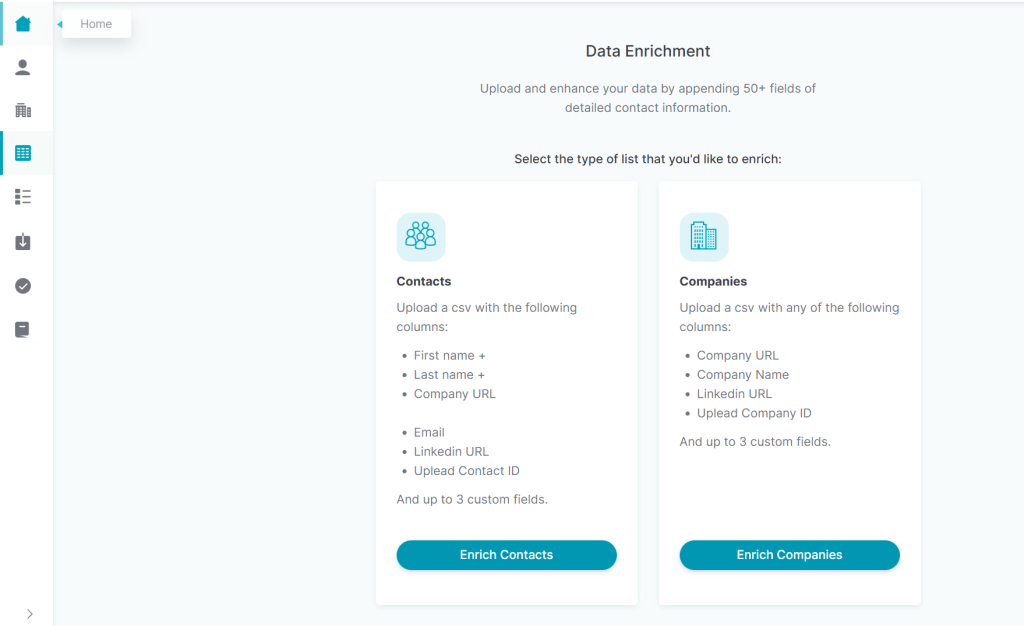
Step 4: Analyze Results with Claude. After downloading your enriched data, use Claude to identify patterns: Review this enriched dataset and identify which job titles have the highest phone number coverage, which industries show the most buying intent signals, and suggest follow-up strategies for each segment:
[paste enriched data sample]Apply these email best practices in your recommendations:
- Prioritize contacts with verified phone numbers for multi-channel outreach
- Use industry-specific pain points in messaging
- Reference specific technologies in their stack for credibility
- Suggest timing based on buying signals and the company growth stage
- Include competitive positioning where relevant
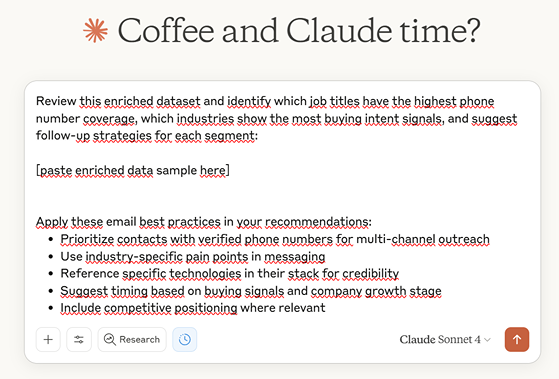
Sample Claude Analysis Output:
Enrichment Analysis Results:
Phone Coverage by Role:
– C-Level executives: 89% coverage
– VPs of Sales/Marketing: 76% coverage
– Directors: 68% coverage
– Managers: 45% coverage
Intent Signal Patterns:
– SaaS companies show 3x higher intent scores
– Companies with 100-500 employees exhibit the strongest buying signals
– Recent funding correlates with 2.4x higher engagement rates
Recommended Follow-up Strategy:
1. Priority tier: C-level + VPs with phone numbers (immediate outreach)
2. Nurture tier: Directors with strong intent signals (email sequences)
3. Long-term tier: Managers and low-intent prospects (quarterly check-ins)
Score & Qualify Leads With AI
AI lead scoring eliminates guesswork from prioritization through analysis of behavioral patterns and firmographic signals to predict which potential customers are most likely to convert leads into paying customers.
Step-by-Step Implementation:
Step 1: Set Up Salesforce Einstein Lead Scoring
Navigate to Setup > Einstein Lead Scoring and configure these key factors:
- Demographic scoring: Company size, industry, job title
- Behavioral scoring: Website visits, email opens, content downloads
- Engagement scoring: Social media interactions, event attendance
Step 2: Define Conversion Events in Salesforce
Create custom fields to track these qualification milestones:
- Demo requested (50 points)
- Pricing page viewed (30 points)
- Case study downloaded (25 points)
- ROI calculator used (40 points)
- Multiple stakeholder engagement (60 points)
Step 3: Create Automated Workflows in Salesforce
Set up these Process Builder rules:
- Leads scoring 80+ automatically assign to senior AEs
- Leads scoring 60-79 enter nurturing sequences in SalesLoft
- Leads scoring 40-59 receive educational content campaigns
- Leads scoring below 40 get minimal follow-up resources
Step 4: Use ChatGPT for Score Interpretation Weekly, export your scored leads, and ask ChatGPT: “Analyze these lead scores and behaviors to identify why high-scoring leads aren’t converting. What patterns suggest adjustments to our scoring model? [paste lead data with scores and outcomes]
Frame your analysis using proven email principles:
- Identify which score ranges respond best to different messaging approaches
- Suggest personalization strategies for high-scoring non-responders
- Recommend follow-up timing based on score and engagement patterns
- Include competitor positioning opportunities for stalled high-value prospects
- Focus on actionable changes to improve conversion rates”
Sample ChatGPT Scoring Analysis:
Lead Scoring Analysis:
Conversion Patterns:
– 87% of leads scoring 80+ convert within 30 days
– Mid-tier leads (60-79) show 34% conversion but longer cycles
– Geographic factor: West Coast leads convert 2.1x faster
Red Flags Identified:
– High scores from job title weighting may be misleading
– Leads engaging with pricing content early often stall in procurement
– Multiple demo requests without stakeholder expansion = low close probability
Scoring Model Adjustments:
1. Reduce job title weight by 15%
2. Add negative scoring for early pricing engagement
3. Increase points for stakeholder expansion activities
4. Add geographic multipliers for high-conversion regions
AI B2B Intent Data
Intent data reveals which companies are actively researching solutions in your category and enables perfectly timed outreach when prospects show buying behavior, rather than interrupting with cold outreach.
Step-by-Step Implementation:
Step 1: Configure Intent Filters in UpLead
Access UpLead’s Intent Data feature and select relevant topics:
- “Marketing Automation” (if you sell MarTech)
- “CRM Data Automation” (for CRM add-ons)
- “Sales Enablement” (for sales tools)
- “Revenue Operations (RevOps)” (for RevOps solutions)
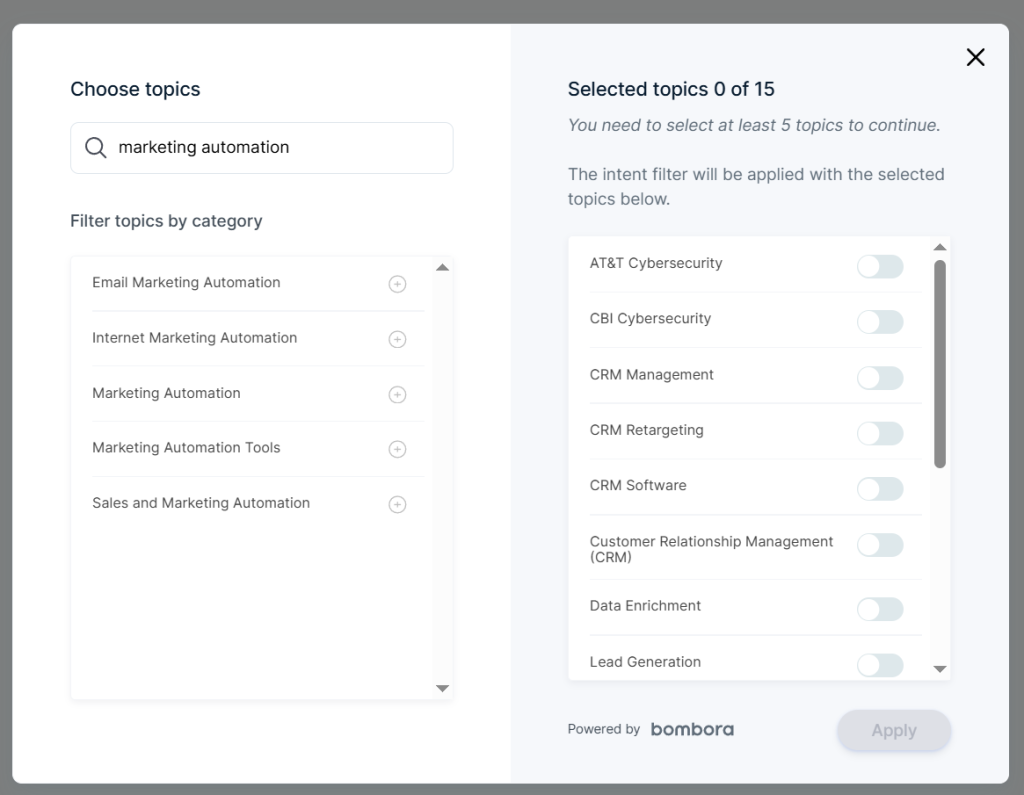
Step 2: Create Outreach.io Sequences for Each Intent Level
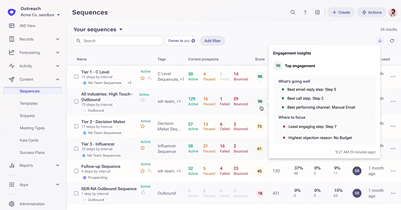
(Source: Outreach)
Build these specialized campaigns based on our proven templates:
High Intent Email Example:
Subject: {{company_name}} – Lead contact data Q3
{{first_name}},
I noticed {{company_name}} has been researching marketing automation solutions recently.
We have a tool that identifies companies actively searching for solutions like yours—before your competitors can engage them.
For example, we recently flagged 247 financial services companies looking for automated lead scoring tools.
Open to learning more? I can provide you with a sample list.
Best,
[Your name]Step 4: Automate Intent Monitoring
Set up Salesforce workflows that:
- Alert account owners when existing accounts show new intent
- Create tasks for BDRs when new companies enter intent database
- Update lead scores automatically based on intent signals
AI Powered Buyer Personas
Traditional buyer personas rely on assumptions. AI-powered tools analyze actual customer behavior across millions of touchpoints to reveal what prospects really care about, which enables more effective targeting and messaging.
Step-by-Step Implementation:
Step 1: Export Customer Data from Salesforce
Pull these data points for all won opportunities in the last 12 months:
- Industry and company size
- Job titles and department structure
- Sales cycle length and deal size
- Content engagement history
- Common objections and concerns
- Decision-making process and stakeholders involved
Step 2: Analyze Patterns with ChatGPT Use this comprehensive prompt based on our persona development process:
Analyze this customer data to identify 3-4 distinct buyer personas. For each persona, define their primary pain points, preferred communication styles, typical objections, content preferences, and decision-making factors. Include buying committee composition and average sales cycle: [paste customer data]
Structure your personas using effective email principles:
- Define specific pain points that resonate in outreach messaging
- Identify communication preferences (formal vs. casual, technical vs. business-focused)
- Note objection patterns to address proactively in emails
- Include social proof preferences (peer reviews vs. executive testimonials)
- Suggest optimal follow-up cadence and channel mix for each persona
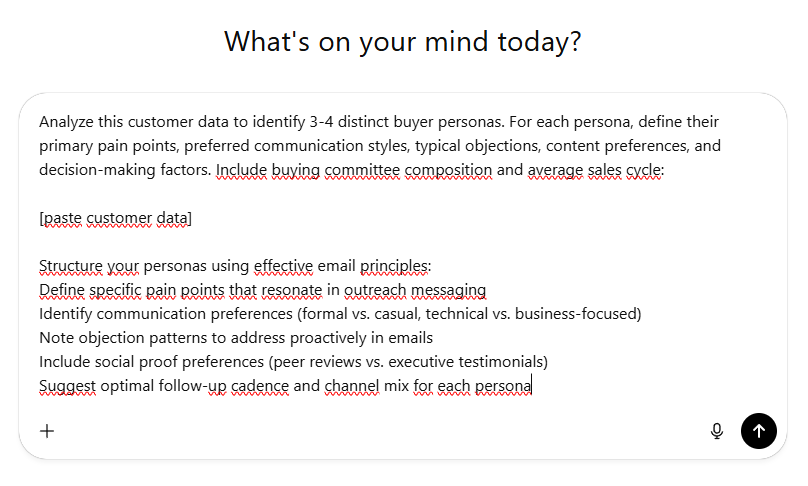
Step 3: Create Persona-Specific SalesLoft Sequences
Create tailored outreach for each persona using our proven frameworks:
Technical Buyer Email Template:
Subject: {{company_name}} integration capabilities
{{first_name}},
Many CTOs at companies like {{company_name}} are concerned about data security and API reliability when evaluating new tools.
Our platform offers SOC 2 compliance, 99.9% uptime SLA, and RESTful APIs with comprehensive documentation.
Would you like to review our technical specifications and security documentation?
Best,
[Your name]Economic Buyer Email Template:
Subject: ROI data for {{company_name}}
{{first_name}},
CFOs typically ask us about ROI and implementation costs. Here’s what matters:
• 340% average ROI within 6 months
• $47,000 average annual savings in data costs
• 2-week implementation timeline
Happy to share a customized ROI calculation for {{company_name}}.
Best,
[Your name]Step 4: Use Claude for Persona Refinement
Use this prompt:
Review these persona performance metrics and customer interview insights to suggest refinements to our buyer personas. Which characteristics predict fastest sales cycles and highest deal values? [paste performance data and feedback]
Apply proven outreach strategies in your recommendations:
- Identify persona characteristics that respond to specific subject line styles
- Note which personas prefer pain-point focused vs. value-proposition messaging
- Suggest optimal personalization tokens for each buyer type
- Include competitor positioning strategies that resonate with each persona
- Recommend follow-up timing and channel preferences based on conversion data
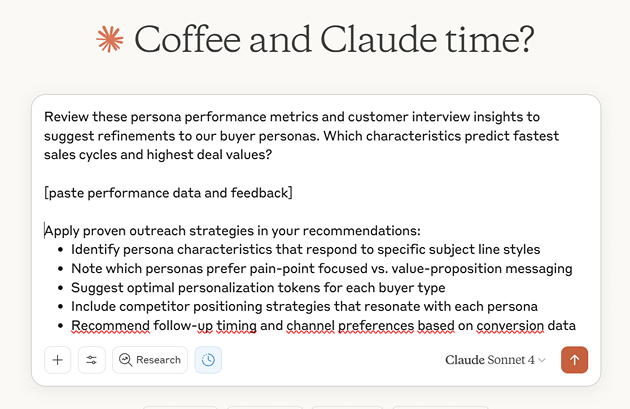
Sample Claude Persona Analysis:
Persona Refinement Analysis:
High-Value Characteristics Identified:
– Technical buyers with API integration experience: 65% faster evaluation cycles
– Economic buyers from high-growth companies (>40% YoY): 2.3x larger deal sizes
– Champions with previous martech consolidation experience: 78% close rate
Sales Cycle Predictors:
– Single-vendor preference: -23 days average cycle time
– Prior tool integration challenges: +45 days evaluation period
– Executive stakeholder involvement early: -34% cycle time reduction
Recommended Persona Updates:
1. Prioritize prospects with integration track records
2. Create expansion-focused messaging for high-growth segments
3. Develop stakeholder mapping guides for complex buying committees
4. Add “integration readiness” as a key qualification criteria
Updated Ideal Customer Profiles:
– Primary: Growing companies with established tech stacks seeking consolidation
– Secondary: Enterprises with complex integration requirements and dedicated IT resources
– Tertiary: Early-stage companies with technical founders leading evaluation
Lead Interaction With AI
Intelligent chatbots handle initial prospect interactions with sophistication that rivals human reps and qualify leads through intelligent questioning while routing qualified prospects to appropriate sales team members.
Step-by-Step Implementation:
Step 1: Configure Salesforce Einstein Bot
Set up these qualification pathways based on our proven conversation design:
- Company size qualification (SMB/Mid-Market/Enterprise routing)
- Use case identification (different solutions/pricing tiers)
- Authority assessment (decision-maker vs. influencer)
- Timeline qualification (immediate need vs. future planning)
- Budget range discovery (without being pushy)
Step 2: Design Conversation Flows
[Screenshot placeholder: Chatbot conversation tree with qualification logic]Create these specific interaction paths using our tested framework:
Initial Engagement: Bot: “Hi! I help companies like {{company_name}} improve their lead generation results. What’s your biggest challenge with finding qualified prospects right now?”
Qualification Questions: Bot: “How large is your sales team?” (sizing question) Bot: “What tools are you currently using for prospecting?” (tech stack discovery) Bot: “When are you looking to improve your lead generation process?” (timeline qualification)
Step 3: Create Outreach.io Follow-Up Sequences
Based on bot qualification outcomes, using our segmentation approach:
- Qualified leads: Immediate human handoff + personalized email
- Nurture leads: Educational content sequence + delayed outreach
- Unqualified leads: Self-service resources + future nurturing
Personalize Your Outreach at Scale
AI-powered personalization goes beyond mail merge fields to create genuinely customized messages that reference specific prospect challenges, recent company news, and relevant use cases that resonate with individual decision makers.
Step-by-Step Implementation:
Step 1: Set Up Outreach.io Dynamic Content
Create these personalization tokens based on our high-performing templates:
- {{company_news}} – Recent announcements or changes
- {{tech_stack_insight}} – Relevant technology observations
- {{industry_challenge}} – Sector-specific pain points
- {{mutual_connection}} – Shared LinkedIn connections
- {{personalized_value}} – Customized value proposition
Step 2: Create AI-Powered Email Templates
Use Claude to generate personalized openers with this proven template:
Write a personalized cold email opener for [prospect name] at [company]. Context: They recently [specific company news], use [technology stack], work in [industry] facing [specific challenge]. Connect our [solution] to their situation without being salesy. Keep it under 50 words.
Best practices to include:
- Start with personalized observation, not generic greeting
- Reference specific pain points before mentioning solutions
- Use soft CTAs with date options rather than aggressive asks
- Include social proof or competitor comparisons when relevant
- Focus on value delivery rather than product features
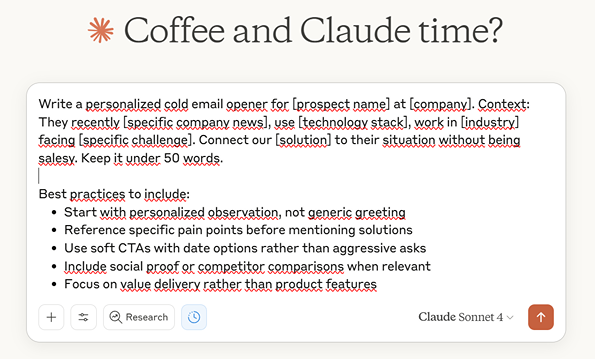
Sample Personalized Email Templates:
Intent-Driven Email (High Performers):
Subject: Lead contact data – Q3
Hey {{first_name}},
I recently came across {{company_name}} while researching companies actively evaluating sales intelligence tools.
We help marketing teams identify in-market prospects before competitors can engage them—using real behavioral signals, not guesswork.
For example, we recently flagged 89 SaaS companies researching revenue operations solutions.
Worth a quick call to share the approach?
Best,
[Your name]Competitor Displacement Email:
Subject: Hi {{first_name}}
{{first_name}},
Many marketing leaders using {{competitor_name}} mention these challenges:
• High pricing that strains budgets ({{competitor_annual_cost}}+ annually)
• Inaccurate data that leads to wasted ad spend
• Complex interface that slows team adoption
UpLead provides 95% accurate contact data with real-time verification, 40-70% cost savings, and intuitive interface your team will actually use.
Open to a 15-minute comparison call?
Looking forward to your response.
Social Proof Email:
Subject: Based on account surge data
Hi {{first_name}},
How would it help your team at {{company_name}} if you had verified contact details with a 95% deliverability guarantee?
Here’s what our customers say on G2 about UpLead’s impact on campaign performance:
“Increased our qualified lead generation by 340% while reducing data costs by 60%” – Marketing Director, SaaS Company
“Finally found a tool that integrates perfectly with Salesforce and actually works” – Revenue Operations Manager
Worth exploring for {{company_name}}?
Best,
[Your name]Step 3: Track and Optimize Performance
Monitor these key personalization metrics:
- Open rates by personalization type (subject line variations, opener styles)
- Response rates for different message variations (pain point focus vs. value proposition)
- Meeting booking rates from personalized vs. generic outreach
- Conversion rates through the entire funnel (email to meeting to opportunity)
Top 5 AI Lead Generation Tools
After testing dozens of platforms, these five AI lead generation tools stand out for their artificial intelligence capabilities, data quality, and proven ROI. Each serves different use cases, so select the right tools based on your specific needs and budget.
1. UpLead
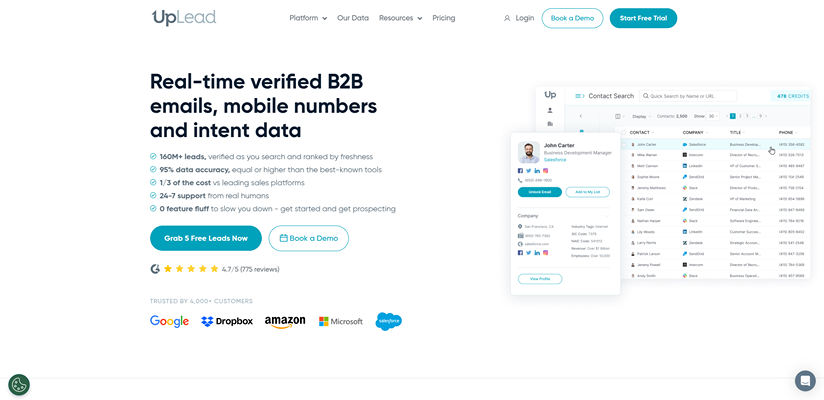
UpLead is the accuracy-focused B2B data provider that combines 95% verified contact data with advanced AI powered lead generation capabilities. The platform’s 160M+ contacts across 30M+ companies provide the foundation for precise AI-driven prospecting that identifies high-value prospects while filtering unqualified leads.
Key AI Features:
- Intent data filters to surface companies actively researching your category
- Technographic targeting based on 27K+ tracked technologies
- Real-time email verification ensuring deliverability
- Chrome extension for LinkedIn prospecting with instant verification
- API integration for automated data enrichment workflows
Pricing:
- Free Trial: $0/7 days (5 credits for free)
- Essentials: from $74/month (2.040 credits annually)
- Plus: from $149/month (4.800 credits annually)
- Professional: Custom pricing (10,000+ credits, advanced AI features)
2. Seamless AI
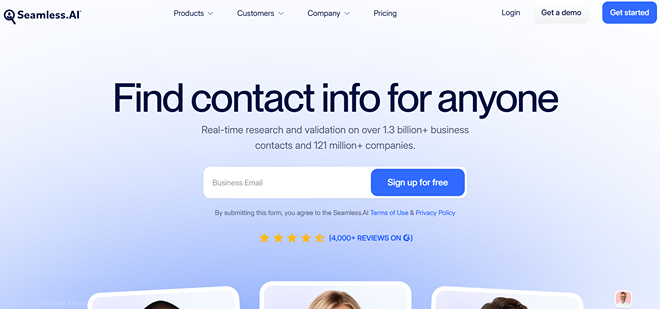
Seamless AI is a real-time contact discovery platform specializing in finding prospects that don’t exist in traditional databases. The platform excels at AI powered prospecting through web scraping and social media analysis, making it ideal for finding hard-to-reach decision makers.
Key AI Features:
- Real-time contact discovery during web browsing
- AI-generated outreach message creation
- Automated verification and enrichment workflows
- Chrome extension for instant prospect capture
- Integration with popular CRM and sales automation tools
Pricing:
- Free: $0 (Free plan with 50 credits)
- Pro: Contact sales (per-user, daily credit refresh; add-ons available.
- Enterprise: Contact sales ( unlimited users, custom credits; enterprise support.)
Learn more about Seamless AI pricing
3. LeadIQ
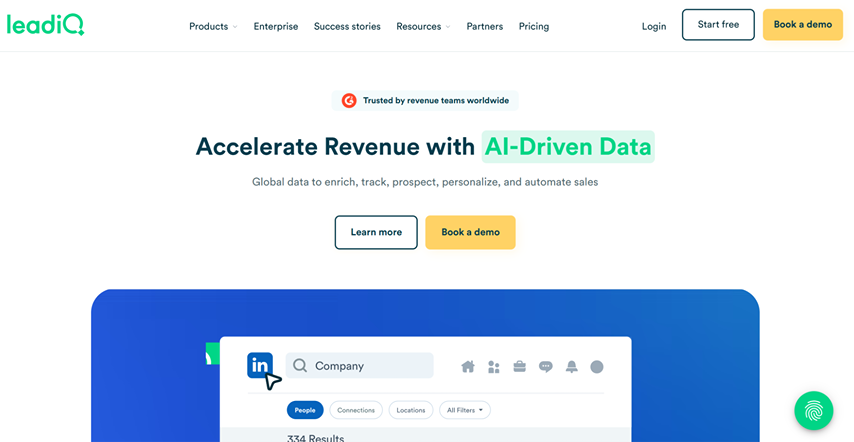
LeadIQ is the LinkedIn-focused prospecting platform designed for mid-market sales teams needing competitive pricing and strong social selling integration. The platform’s Scribe AI feature generates personalized email sequences based on prospect LinkedIn activity and profile data.
Key AI Features:
- AI-powered email sequence generation (Scribe AI)
- LinkedIn profile analysis and outreach automation
- Job change tracking and opportunity identification
- CRM integration with automated data sync
- Chrome extension for LinkedIn prospecting workflows
Pricing:
- Free Trial: 30 days
- Free: $0 (1 user / 50 credits)
- Pro: $200/month (credit-based; slider on pricing page).
- Enterprise: Contact them (adds governance/admin & advanced features).
Read our LeadIQ pricing breakdown
4. ZoomInfo
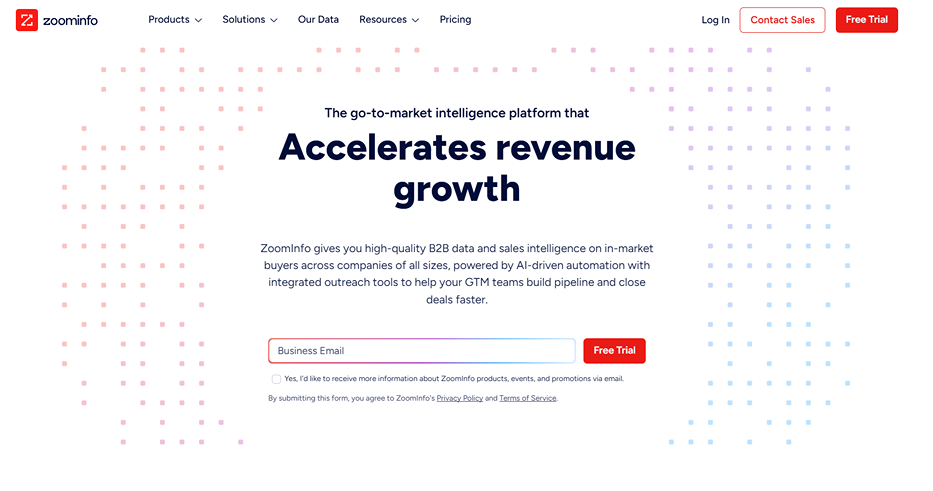
ZoomInfo is the comprehensive B2B intelligence platform combining extensive contact databases with advanced AI analytics for enterprise sales teams. The platform provides intent data, technographic insights, and predictive analytics to identify and engage the best leads at optimal timing.
Key AI Features:
- Advanced intent data and buyer behavior analysis
- Predictive lead scoring and opportunity identification
- Automated prospecting workflows and sequence optimization
- Real-time contact and company data verification
- Integration with major CRM and sales engagement platforms
Pricing:
- Professional: Contact sales
- Advanced: Contact sales
- Elite (incl. Elite+): Contact sales
5. CoPilot AI
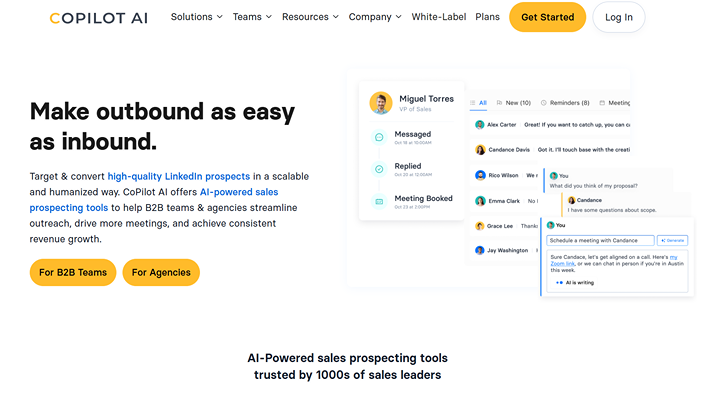
CoPilot AI is the LinkedIn automation specialist focused exclusively on social selling with premium AI capabilities. The platform requires LinkedIn Sales Navigator integration and maintains compliance while maximizing connection and response rates through intelligent messaging.
Key AI Features:
- AI-generated LinkedIn connection requests and messages
- Profile analysis for personalization triggers
- Automated follow-up sequence management
- LinkedIn compliance monitoring and safety features
- Integration with CRM systems for lead tracking
Pricing:
- Core: $203/month (annual)
- Guided: $294/month (annual)
- Teams/White-label: Request quote.
Thinking About the Future of AI Lead Generation
The next wave of AI for lead generation will center on autonomous agents that handle complete prospecting workflows without human intervention, which fundamentally reshapes how sales and marketing teams operate.
Autonomous Prospecting Agents
Implementation Roadmap: AI agents will execute these complete workflows:
Step 1: Autonomous Research Phase
- Monitor industry publications and company websites for trigger events automatically
- Analyze job postings to identify expansion signals and hiring patterns in real-time
- Track technology adoptions through web scraping and API monitoring continuously
- Compile comprehensive company profiles with buying signals and organizational changes
Step 2: Intelligent Outreach Orchestration
- Generate personalized multi-channel campaigns across email, LinkedIn, and phone automatically
- A/B test message variations and optimize based on response rates without human input
- Handle initial objections and qualification questions through advanced natural language processing
- Schedule meetings directly based on prospect availability and sales rep calendars
Step 3: Continuous Relationship Management
- Monitor prospect engagement across touchpoints and adjust messaging accordingly in real-time
- Identify optimal follow-up timing based on behavioral patterns and industry benchmarks
- Escalate high-priority opportunities to human reps at precisely the right moment
- Maintain nurturing relationships with long-term prospects through value-driven content automation
Predictive Market Intelligence
Advanced AI will revolutionize market opportunity identification through real-time analysis of economic indicators, competitive intelligence, and buyer behavior patterns.
Specific Implementation: Step 1: Intent Signal Aggregation
- Monitor patent filings, regulatory changes, and funding announcements to predict market shifts 6-12 months ahead
- Track competitor hiring, technology investments, and customer losses to identify target account opportunities automatically
- Analyze GDP growth, industry investment, and budget cycle data to optimize timing for different market segments
Step 2: Behavioral Pattern Recognition
- Aggregate web browsing behavior, content consumption patterns, and search trends across industries
- Identify buying committee formation signals through LinkedIn activity and organizational changes
- Predict technology adoption cycles based on competitive intelligence and market movement analysis
Gartner research shows predictive analytics will enable 75% of B2B sales organizations to supplement traditional lead scoring with AI-driven behavioral analysis by 2026.
Hyper-Personalization at Enterprise Scale
The convergence of AI with account-based marketing will create surgical precision in targeting individual stakeholders within target accounts.
Strategic Implementation Framework: Step 1: Individual Stakeholder Modeling
- Create detailed profiles for each decision maker, including communication preferences, influence patterns, and decision-making triggers
- Map relationship networks within target accounts to identify optimal entry points and influence pathways
- Track individual engagement patterns across multiple touchpoints to predict optimal outreach timing
Step 2: Dynamic Content Generation
- Generate real-time personalized messaging based on recent behavior, industry events, and buying committee dynamics
- Create customized content assets (case studies, ROI calculators, technical documentation) for specific stakeholder types
- Orchestrate multi-stakeholder campaigns that automatically adjust messaging, timing, and channel selection
Step 3: Predictive Engagement Optimization
- Use machine learning to predict optimal communication channels and timing for each individual stakeholder
- Automatically adjust message tone, technical depth, and call-to-action based on persona and engagement history
- Optimize meeting scheduling and proposal timing based on organizational decision-making patterns
Privacy-Compliant Data Intelligence
Future AI lead generation will balance personalization with increasing privacy regulations through advanced anonymization and consent management technologies.
Compliance-First Approach: Step 1: Zero-Party Data Optimization
- Maximize insights from explicitly provided customer data while minimizing reliance on third-party sources
- Create value-exchange mechanisms that encourage prospects to share information voluntarily
- Build preference centers that allow granular control over data usage and communication preferences
Step 2: Probabilistic Modeling
- Infer buyer intent and preferences from aggregated, anonymized behavioral patterns rather than individual tracking
- Use cohort analysis and statistical modeling to maintain personalization while ensuring data privacy
- Implement differential privacy techniques to extract insights while protecting individual identity
Step 3: Consent Intelligence
- Optimize opt-in rates through AI-powered consent flow testing and personalization
- Dynamically manage preference centers based on regulatory requirements and customer comfort levels
- Predict consent likelihood and optimize data collection strategies accordingly
Research from Forrester shows privacy-compliant personalization will become a competitive differentiator, with 89% of customers more likely to engage with companies that demonstrate transparent data practices.
These trends point toward a future where AI handles the entire lead generation lifecycle while maintaining human oversight for strategic decisions and relationship building, which ensures data privacy compliance throughout the process.
FAQs About AI Lead Generation
Yes, you can use AI to generate leads through automated prospecting, lead scoring, intent data analysis, and personalized outreach campaigns. Modern AI lead generation tools handle everything from identifying prospects to qualifying opportunities and scheduling meetings with decision makers.
The best AI lead generation tools depend on your specific needs: UpLead excels in data accuracy and intent data, Seamless AI offers real-time contact discovery, LeadIQ provides strong LinkedIn integration, and ZoomInfo delivers comprehensive enterprise functionality. Choose tools based on your budget, team size, and primary lead sources.
You can use ChatGPT for lead generation by leveraging it for prospect research, crafting personalized outreach messages, analyzing company websites for pain points, creating buyer personas, and generating follow-up sequences. ChatGPT excels at analyzing large datasets to identify patterns and generating compelling messaging that resonates with potential customers.
You qualify leads using AI through predictive scoring models that analyze firmographic data, behavioral signals, intent indicators, and historical conversion patterns to assign probability scores. AI algorithms automatically route high-potential prospects to appropriate sales workflows while filtering out unqualified leads, improving overall lead quality and conversion rates.

